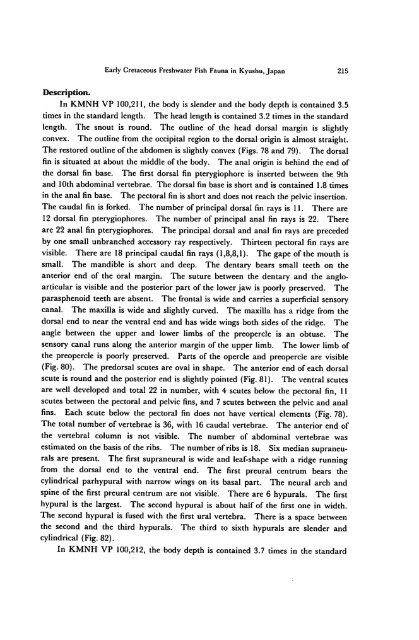Early Cretaceous Freshwater Fish Fauna in Kyushu, Japan
Early Cretaceous Freshwater Fish Fauna in Kyushu, Japan
Early Cretaceous Freshwater Fish Fauna in Kyushu, Japan
You also want an ePaper? Increase the reach of your titles
YUMPU automatically turns print PDFs into web optimized ePapers that Google loves.
<strong>Early</strong><strong>Cretaceous</strong> <strong>Freshwater</strong> <strong>Fish</strong> <strong>Fauna</strong> <strong>in</strong> <strong>Kyushu</strong>, <strong>Japan</strong> 215<br />
Description.<br />
In KMNH VP 100,211, the body is slender and the body depth is conta<strong>in</strong>ed 3.5<br />
times <strong>in</strong> the standard length. The head length is conta<strong>in</strong>ed 3.2 times <strong>in</strong> the standard<br />
length. The snout is round. The outl<strong>in</strong>e of the head dorsal marg<strong>in</strong> is slightly<br />
convex. The outl<strong>in</strong>e from the occipital region to the dorsal orig<strong>in</strong> is almost straight.<br />
The restored outl<strong>in</strong>e of the abdomen is slightly convex (Figs. 78 and 79). The dorsal<br />
f<strong>in</strong> is situated at about the middle of the body. The anal orig<strong>in</strong> is beh<strong>in</strong>d the end of<br />
the dorsal f<strong>in</strong> base. The first dorsal f<strong>in</strong> pterygiophore is <strong>in</strong>serted between the 9th<br />
and 10th abdom<strong>in</strong>al vertebrae. The dorsal f<strong>in</strong> base is short and is conta<strong>in</strong>ed 1.8 times<br />
<strong>in</strong> the anal f<strong>in</strong> base. The pectoral f<strong>in</strong> isshortand does not reach the pelvic <strong>in</strong>sertion.<br />
The caudal f<strong>in</strong> is forked. The number of pr<strong>in</strong>cipal dorsal f<strong>in</strong> rays is 11. There are<br />
12 dorsal f<strong>in</strong> pterygiophores. The number of pr<strong>in</strong>cipal anal f<strong>in</strong> rays is 22. There<br />
are 22 anal f<strong>in</strong> pterygiophores. The pr<strong>in</strong>cipal dorsal and anal f<strong>in</strong> rays are preceded<br />
by one small unbranched accessory ray respectively. Thirteen pectoral f<strong>in</strong> rays are<br />
visible. There are 18 pr<strong>in</strong>cipal caudal f<strong>in</strong> rays (1,8,8,1). The gape of the mouth is<br />
small. The mandible is short and deep. The dentary bears small teeth on the<br />
anterior end of the oral marg<strong>in</strong>. The suture between the dentary and the angloarticular<br />
is visible and the posterior part of the lowerjaw is poorly preserved. The<br />
parasphenoid teeth are absent. The frontal is wide and carries a superficial sensory<br />
canal. The maxilla is wide and slightly curved. The maxilla has a ridge from the<br />
dorsal end to near the ventral end and has wide w<strong>in</strong>gs both sides of the ridge. The<br />
angle between the upper and lower limbs of the preopercle is an obtuse. The<br />
sensory canal runs along the anterior marg<strong>in</strong> of the upper limb. The lower limb of<br />
the preopercle is poorly preserved. Parts of the opercle and preopercle are visible<br />
(Fig. 80). The predorsal scutes are oval <strong>in</strong> shape. The anterior end of each dorsal<br />
scute is round and the posterior end is slightly po<strong>in</strong>ted (Fig. 81). The ventral scutes<br />
are well developed and total 22 <strong>in</strong> number, with 4 scutes below the pectoral f<strong>in</strong>, 11<br />
scutes between the pectoral and pelvic f<strong>in</strong>s, and 7 scutes between the pelvic and anal<br />
f<strong>in</strong>s. Each scute below the pectoral f<strong>in</strong> does not have vertical elements (Fig. 78).<br />
The total number of vertebrae is 36, with 16 caudal vertebrae. The anterior end of<br />
the vertebral column is not visible. The number of abdom<strong>in</strong>al vertebrae was<br />
estimated on the basis ofthe ribs. The number ofribs is 18. Six median supraneu<br />
rals are present. The first supraneural is wide and leaf-shape with a ridge runn<strong>in</strong>g<br />
from the dorsal end to the ventral end. The first preural centrum bears the<br />
cyl<strong>in</strong>drical parhypural with narrow w<strong>in</strong>gs on its basal part. The neural arch and<br />
sp<strong>in</strong>e of the first preural centrum are not visible. There are 6 hypurals. The first<br />
hypural is the largest. The second hypural is about half of the first one <strong>in</strong> width.<br />
The second hypural is fused with the first ural vertebra. There is a space between<br />
the second and the third hypurals. The third to sixth hypurals are slender and<br />
cyl<strong>in</strong>drical (Fig. 82).<br />
In KMNH VP 100,212, the body depth is conta<strong>in</strong>ed 3.7 times <strong>in</strong> the standard

















